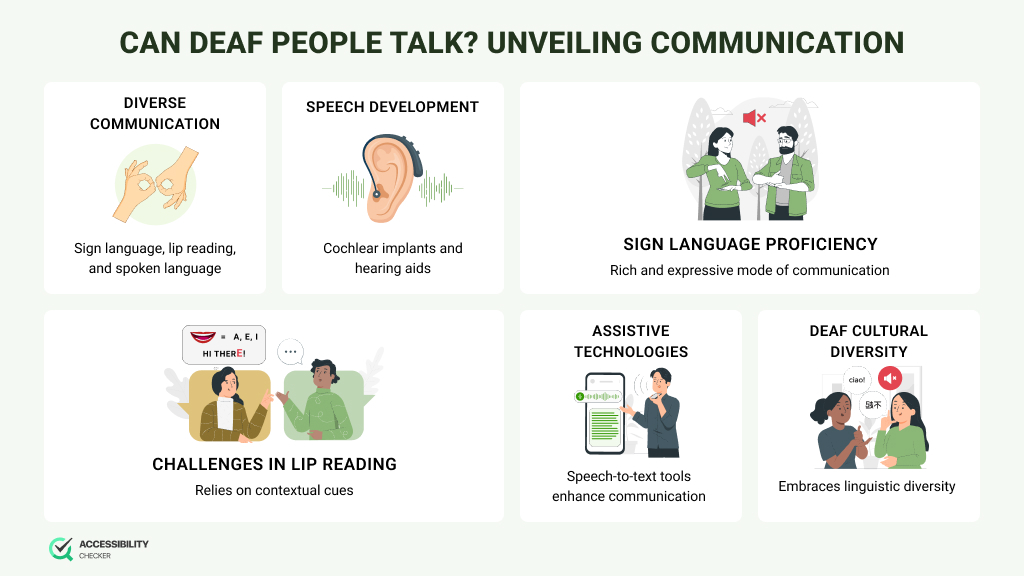Can Deaf People Talk? (and Other Common Questions Answered)
According to the World Health Organization (WHO) (1), over 460 million people across the globe have some form of hearing impairment, with deafness being the most severe form of hearing loss.
While many people are born with deafness due to genetics or infections, others may lose their hearing later in life because of underlying health conditions, an injury, or prolonged exposure to loud noises.
There are many questions about how the deaf and hard of hearing live their lives. We’re going to answer some of the most common questions in this blog.

Can Deaf People Talk?
The answer to this question mainly depends on whether someone was born with hearing loss. If someone has never heard spoken language, they are usually unable to talk at all. However, if they lost their hearing later in life, they may have some vocal capabilities that allow them to speak. For those who still have some residual hearing left, speech may still be possible.
How Do Deaf People Learn to Speak?
When a child is less than a year old, they learn to speak by taking auditory cues from their parents and surroundings. This includes different sounds as well as tone of voice.
Learning to speak is much easier for someone who isn’t completely deaf or only lost their hearing later in life. This gave them time to acquire some speech skills. For these individuals, speech training can help reinforce language skills. A speech therapist or language pathologist can help them practice different sounds and learn how to control voice tone and volume.
For someone who was born deaf, learning to speak is a much lengthier process, but by starting early, speech becomes possible. Assistive devices can also be used in some instances, depending on the severity of the hearing loss.
Along with general speech training, auditory training also plays a role in teaching a person with a hearing impairment to speak. This involves listening to sounds, phrases, and syllables. Another strategy is to teach someone to lip-read. This will allow them to still be involved in a conversation with little to no assistance from assistive devices.
So, yes, someone who is born deaf can learn to speak.
Can Deaf People Hear Their Thoughts?
Yes, deaf people can hear an inner voice, but how it comes through depends on when the deafness occurred. Some may think in American Sign Language, while others will think in the language they initially learned.
It should also be noted that sometimes, a deaf person’s thinking process can be quite different. For example, when they imagine a person speaking to them, that person may be signing instead of physically speaking. It should also be noted that there aren’t always signs for every word, so a deaf person may spell it out with their fingers when they’re reading text.
Do Deaf People Hear Their Own Voices When Speaking?
Various studies and surveys have shown that, in some instances, a deaf person will hear their own voice when they speak. However, when they lost their hearing will determine whether this is possible.
Basically, a deaf person who was once able to hear their voice can still pair the sound with certain words. In other cases, they will think in words but without the sounds.
Interestingly, a neuroimaging study (2) showed that the speech-associated areas of the brain are activated in many people who think in sign. This indicates that there are neural pathways that separate how someone thinks in a language versus how it actually sounds or is delivered.
It also helps to consider the fact that both people who can hear and those who are deaf think differently. While some people think in words and narrations, others will think in images. Even if someone can hear, they may still think in images more often than they would hear their voice. However, because most people with hearing impairments communicate visually, they more often tend to think visually too.
Technology that Helps Deaf People Speak
To make it easier for the deaf and hard-of-hearing community to still engage with people in their daily lives, there’s a range of assistive technology they can take advantage of. These devices are particularly useful in the classroom and working environments.
- Instant messaging. Even though most of us already use instant messaging in our day-to-day lives, they can be used for assistive purposes too. When making a phone call is challenging or impossible, instant messaging is an excellent alternative.
- Video chat. Since most of the hearing-impaired community communicates using sign language, video chat is another useful engagement tool in both social and work situations.
- Internet captioned telephone service. This is a tool that makes it possible to still have telephone conversations. Internet captioned telephone services provide real-time captions on a phone screen. IP relay devices are very similar to this, making it possible to talk to someone over the phone on almost any device with an internet connection.
- Text-to-speech software. Devices such as the OrCam MyEye Pro 3 can turn handwritten notes and online content into speech, making it easier for deaf people to communicate with others.
- Alerting systems. When someone is unable to hear, school bells and alarms become useless. Alerting systems rely on vibrations and blinking lights to alert someone to an alarm or bell when needed.
- Telephone relay services. This phone call device is one that doesn’t require an internet connection. Instead, you’re able to communicate with someone over the phone using a keyboard.
- Video relay services. For deaf people who primarily communicate using American Sign Language, a video relay service can be useful. This technology makes it possible to still communicate with someone even if they don’t understand sign language.
- Sign language translators. This assistive technology focuses on helping deaf people learn by translating written text into sign language.
- Cochlear implants. In some instances, cochlear implants are an option. They’re implanted into the heads of people with complete deafness, allowing them to hear again to some degree. However, it should be noted that it won’t be exactly the same as someone who doesn’t have a hearing impairment.
Empowering the Deaf Community
Even though hearing loss has its limitations, it doesn’t mean the deaf community can’t still live fulfilling lives. With the help of assistive technology and the community around them, people who are hard of hearing can still work, educate themselves, and enjoy exciting social lives.
It also helps that American Sign Language is now an official language, and countless people are taking the time to learn how to communicate with people who can’t hear, even if they don’t know a deaf person themselves. Overall, there’s been a massive positive shift towards creating a more inclusive society for everyone thanks to acts such as the ADA and AODA, so the future’s looking brighter than ever.
FAQs
There are a number of ways that you can communicate with deaf people, starting with learning American Sign Language (ASL), which is now an official language. There is also a range of assistive technology that can help, with instant messaging and video chat being some of the options. Many deaf people can also read lips and have some speech capabilities, so it’s not impossible to have a conversation with them. Finally, there’s also the option of finding a sign language interpreter who can guide your conversations until you have a better grasp of ASL.


